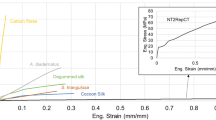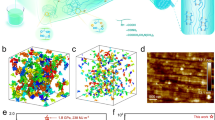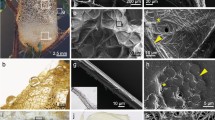These extraordinary composite fibres can be woven into electronic textiles.
Abstract
The energy needed to rupture a fibre (its toughness) is five times higher for spider silk than for the same mass of steel wire, which has inspired efforts to produce spider silk commercially1,2,3. Here we spin 100-metre-long carbon-nanotube composite fibres that are tougher than any natural or synthetic organic fibre described so far, and use these to make fibre supercapacitors that are suitable for weaving into textiles.
This is a preview of subscription content, access via your institution
Access options
Subscribe to this journal
Receive 51 print issues and online access
$199.00 per year
only $3.90 per issue
Buy this article
- Purchase on SpringerLink
- Instant access to full article PDF
Prices may be subject to local taxes which are calculated during checkout


Similar content being viewed by others
References
Kubik, S. Angew. Chem. Int. Edn 41, 2721–2723 (2002).
Vollrath, F. & Knight, D. P. Nature 410, 541–548 (2001).
Lesuer, D. R. et al. Metallurg. Mater. Trans. A 30, 1559–1568 (1999).
Vigolo, B. et al. Science 290, 1331–1334 (2000).
Vigolo, B., Poulin, P., Lucas, M., Luanois, P. & Bernier, P. Appl. Phys. Lett. 81, 1210–1212 (2002).
Poulin, P., Vigolo, B. & Launois, P. Carbon 40, 1741–1749 (2002).
Nikolaev, P. et al. Chem. Phys. Lett. 313, 91–97 (1999).
Jiang, K., Li, Q. & Fan, S. Nature 419, 801 (2002).
Chand, S. J. Mater. Sci. 35, 1303–1313 (2000).
Walters, D. A. et al. Appl. Phys. Lett. 74, 3803–3805 (1999).
Yu, M.-F, Files, B. S., Arepalli, S. & Ruoff, R. S. Phys. Rev. Lett. 84, 5552–5555 (2000).
Zhu, H. W. et al. Science 296, 884–886 (2002).
Mamedov, A. A. et al. Nature Mater. 1, 190–194 (2002).
Author information
Authors and Affiliations
Corresponding author
Ethics declarations
Competing interests
The authors declare no competing financial interests.
Supplementary information
Rights and permissions
About this article
Cite this article
Dalton, A., Collins, S., Muñoz, E. et al. Super-tough carbon-nanotube fibres. Nature 423, 703 (2003). https://doi.org/10.1038/423703a
Issue date:
DOI: https://doi.org/10.1038/423703a
This article is cited by
-
Effects of Functionalized Multi-walled Carbon Nanotubes on the Performance of Wood–Plastic Composites
Fibers and Polymers (2024)
-
A Review of Multifunctional Nanocomposite Fibers: Design, Preparation and Applications
Advanced Fiber Materials (2024)
-
Multiscale Theories and Applications: From Microstructure Design to Macroscopic Assessment for Carbon Nanotubes Networks
Chinese Journal of Mechanical Engineering (2023)
-
Hierarchically structured bioinspired nanocomposites
Nature Materials (2023)
-
Effect of SiO2-MWCNTs on Mechanical and Tribological Properties of Acrylic Silicone Resin Coating
Journal of Inorganic and Organometallic Polymers and Materials (2023)



